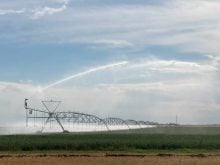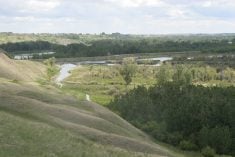It’s been a remarkable turnaround for private irrigators along the Milk River in southern Alberta after farmers and ranchers looking at another dry year along the waterbody that slinks across the international border hit the precipitation jackpot.
“We really won the lottery with the way the spring went,” said Tim Romanow, executive director of the Milk River Watershed Council.
Water allocations along the river are governed by an international treaty that prescribes how much and when the resource can be drawn on the Canadian side before reaching Montana irrigators in the eastern portion of the state. That treaty balances water allocations with the St. Mary’s River, which has its headwaters in the United States before it flows north of the border.
Read Also

VIDEO: Agritechnica Day 4: Robots and more robots, Nexat loves Canada and the trouble with tariffs
Agritechnica Day 4: Robots and more robots, Nexat loves Canada and the trouble with tariffs.
In May, irrigators were expecting another early shut-off to water access along the Milk River, following last year’s drought and a 2020 failure of a diversion system from the St. Mary’s River, which bolsters stream flows on the Milk.
But predictions of another low-water year quickly evaporated. The precipitation that fell in June came down as snow near the mountain headwaters of the river system, and that allowed Montana’s off-stream storage to catch much of the runoff.
“Even if the clouds don’t open up again and we get back to a zero or near-zero natural flow situation on the Milk the rest of the way this summer, we still have 2,000 CFS (cubic feet per second) days of water,” said Romanow. “If we were to get to zero flow in a week or two, that would carry us through at a minimum to Aug. 15 or 20.”
The June rainfall also allowed many southern Alberta crops and pastures to improve soil moisture levels, which will also ease pressure for irrigators, said Romanow.
“In the western edge of the watershed, we got maybe three inches (76 millimetres) of rain in those couple of weeks of storms that we had,” he said. “The dryland crops and forages look really good right now.”
But soil moisture deficits remain high in the region, cautioned Romanow.
That has a number of the ranchers along the Milk River looking for alternatives to pump water to where it’s needed.
“That’s going to be a challenge. The rain was great but we didn’t get enough runoff to fill a lot of water sources. It’s incredible how the ground just soaked it up,” he said.
The management system for the more than century-old water treaty is run through the International Joint Commission (IJC), which announced last year it was conducting a four-year review of how to ensure sustainability of supply on both sides of the border.
Romanow said a recent on-site visit by commission officials from both the U.S. and Canada has given him hope that long-promised changes may come.
The timing of the visit came following the news that more water would be available for Milk River irrigators, which Romanow said allowed for discussions focused on the future.
“Instead of complaining about the situation this year on the river, we were able to take a step back and say, ‘OK, how can we improve this so we don’t have these ups and downs every single year.’ ”















